 |
 |
 |
| |
Pooled 24-week results of DUET-1 and -2: efficacy of TMC125 in treatment-experienced HIV-1-infected patients
|
| |
| |
Reported by Jules Levin
IDSA Oct 7, 2007, San Diego
C Hicks, P Cahn, J Leider, G Pialoux, M Peeters, J Vingerhoets
and B Woodfall on behalf of the DUET-1 and DUET-2 study groups
AUTHOR CONCLUSIONS
In treatment-experienced patients, including those with NNRTI resistant virus, TMC125 was superior to placebo
- 59% of patients achieved confirmed undetectable viral load (<50 copies/mL) with TMC125 + BR at Week 24
Even in the absence of any other fully active background agents (PSS = 0), with TMC125, 45% of patients achieved undetectable (<50 copies/mL) viral load
- response rates increased as more active agents were used in the BR
Better responses were achieved in patients with higher CD4 cell counts and lower viral loads for both treatment arms
- higher responses were apparent with TMC125 compared with placebo, for all categories of baseline viral load or CD4 cell count
13 TMC125 RAMs were identified
- an increasing number of TMC125 RAMs was associated a decreasing response in both treatment arms
- in the TMC125 group, the greatest added benefit was seen with <3 TMC125 RAMs
- 86% of patients had <3 TMC125 RAMs
TMC125 demonstrated significant activity and provides a new treatment option for patients with resistance to other NNRTIs
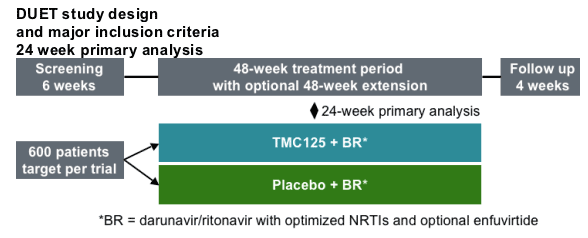
DUET-1 and -2 differed only in geographical location; pooled analysis was pre-specified
Major inclusion criteria:
- Plasma viral load >5,000 HIV-1 RNA copies/mL and stable therapy for ≥8 weeks
- ≥1 NNRTI mutation,* at screening or in documented historical genotype
- ≥3 primary PI mutations at screening
Patients recruited from Thailand, Australia, Europe and the Americas
*From extended list of NNRTI mutations (Tambuyzer et al. Abstract 67 EHDRW 2007);
BR = background regimen
Baseline characteristics
and background ARVs
Prior use of DRV: 62% TMC, 63% PLB.
Detectable mutations: 2 or more NNRTI mutations: 66% in both groups
2 or more IAS USA NNRTI mutations: 43% TMC, 42% PLB.
4 or more primary PI mutations: 62% TMC, 63% PLB.
Background regimen:
Used Fuzeon: 46% TMC, 47% PLB.
Used Fuzeon de novo: 26% TMC, 27% PLB.
Active background agents=0: 17% TMC, 16% PLB.
Active background agents=1: 36% TMC, 39% PLB.
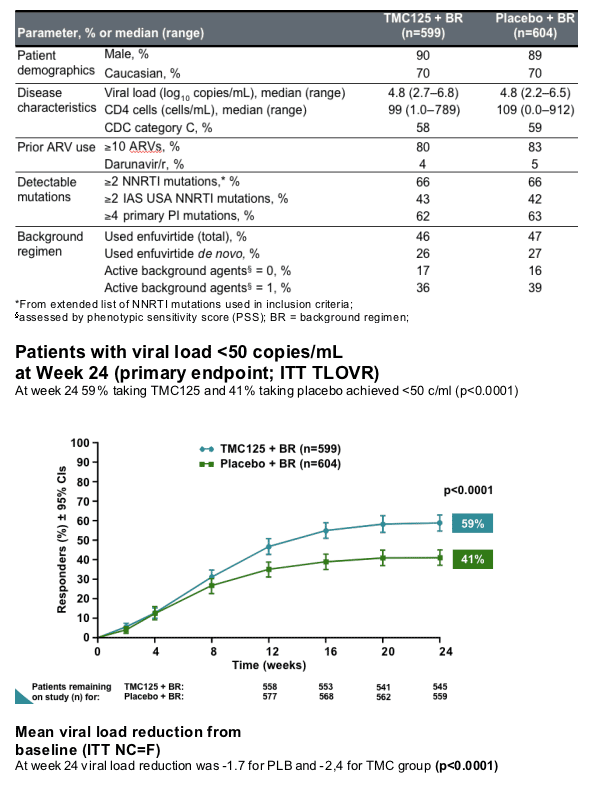
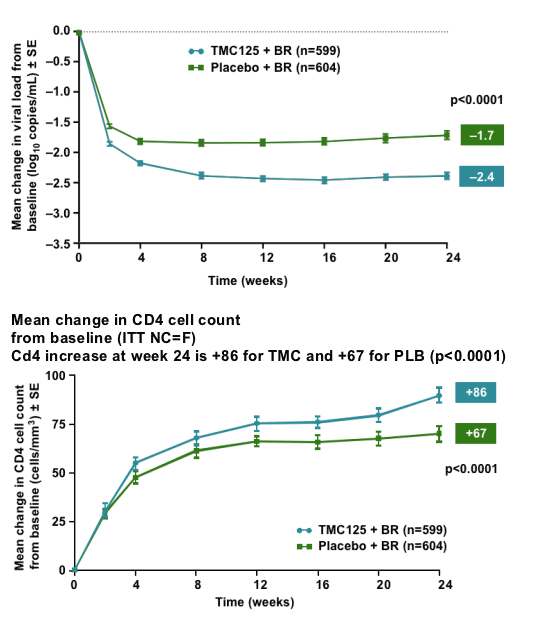
CD4 cell count increase to
50 cells/mm3 or above
- At baseline, 36% and 35% of patients in the TMC125 and placebo groups respectively had a CD4 cell count below 50 cells/mm3 (n=422 in total)
- At Week 24 in the TMC125 group 74% of these patients had moved above the 50 cells/mm3 threshold (n=157), compared with 55% in the placebo group (n=115)
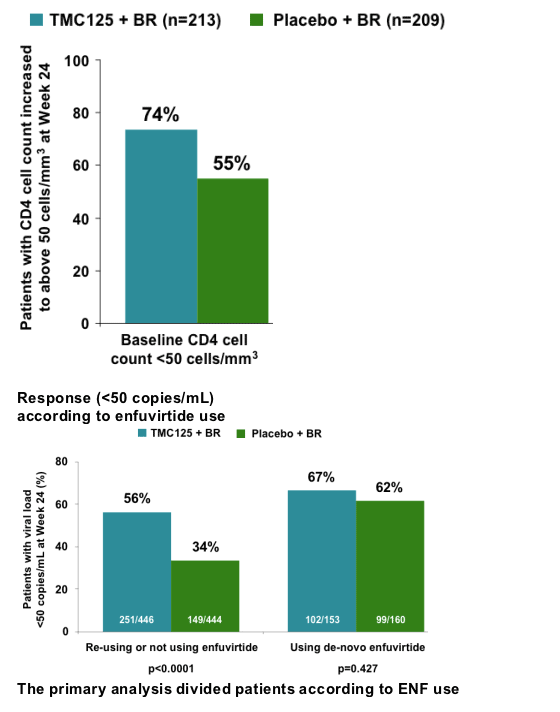
Response (<50 copies/mL)
according to enfuvirtide use
The primary analysis divided patients according to ENF use
Response (<50 copies/mL) according
to baseline darunavir fold change
It appears in this table that patients with increasing DRV resistance had important response to TMC125: for patients with DRVFC<10 at baseline 71% achieved <50 c/ml when taking tmc125 vs 56% for patients taking placebo; for patients with DRV FC 10-40 57% vs 30% taking DRV vs placebo achieved <50 c/ml; and for patients with DRV FC over 40 44% taking TMC125 achieved <50 c/ml vs 2% taking placebo.
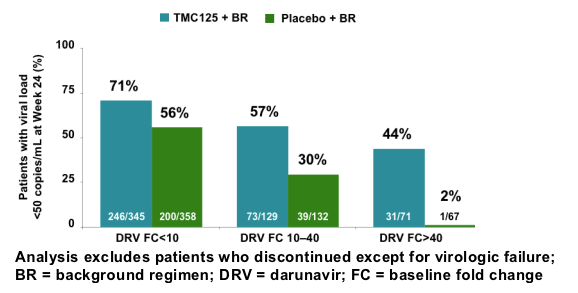
Analysis excludes patients who discontinued except for virologic failure;
BR = background regimen; DRV = darunavir; FC = baseline fold change
Response (<50 copies/mL) according
to number of active background ARVs
- Patients with 0 fully active ARVs in background: 45% taking TMC125 achieved <50 c/ml vs 8% in placebo arm.
- Patients with 1 fully active ARV in background: 60% taking TMC125 vs 30% placebo.
- Patients taking 2 or more fully active background ARVs: 74% for TMc125 vs 67% for placebo.
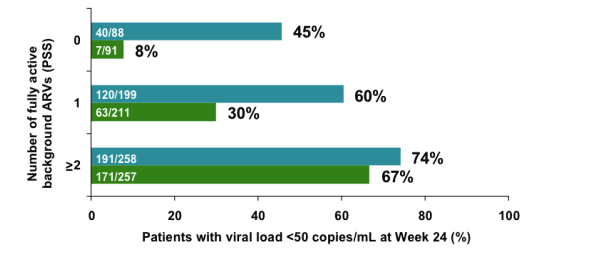
Analysis excludes patients who discontinued except for virologic failure; PSS = phenotypic sensitivity score; darunavir and enfuvirtide are counted as fully active if FC<10 or used de novo, respectvol
Response (<50 copies/mL) according
to baseline viral load and CD4 cell count
The beneficial effects of adding TMC125 vs placebo occurred for patients regardless of baseline viral load or cd4 count so that patients with high viral load at baseline of over 100,000 or cd4 count of <50 received much more benefit be adding TMC125 vs placebo. For example if viral load was >100,000 44% taking TMC125 vs 26% for placebo achieved <50 c/ml and for patients with <50 CD4 at baseline 39% taking TMC125 vs 23% taking placebo achieved <50 c/ml. This differences be adding tMC125 vs placebo also occurred for viral load groups of <30,000 and 30,000 to 99,999, and for patients with CD4s of 50-199, and >200.
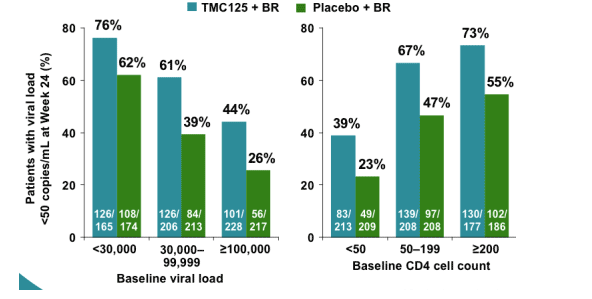
Mutations associated with a
decreased response to TMC125
*A decreased response was defined as ≦75% of the response for patients with zero NNRTI mutations at baseline from the extended NNRTI mutation list; RAM = resistance-associated mutation
Using the data from these trials, 13 baseline mutations were found to be associated with a decreased response to TMC125 (TMC125 RAMs)*:
V90I A98G
L100I K101E/P
V106I V179D/F
Y181C/I/V G190A/S
These TMC125 RAMs occurred mainly in the presence of other NNRTI mutations K103N is not associated with resistance to TMC125
Response (<50 copies/mL) according
to number of TMC125 RAMS
- The greatest added benefit in the TMC125 versus placebo group was seen in patients with <3 TMC125 RAMs
- 86% of patients had <3 TMC125 RAMs
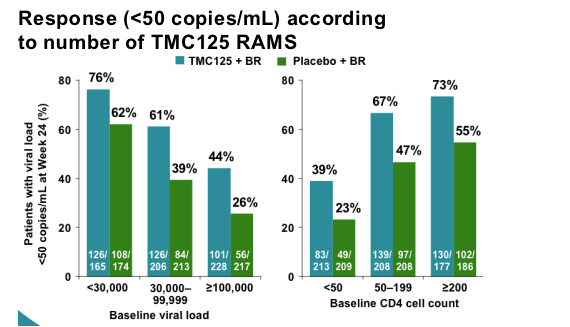
Analysis excludes patients who used de-novo enfuvirtide or discontinued except for virologic failure
|
| |
|
 |
 |
|
|